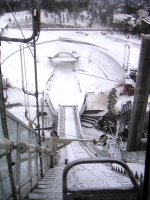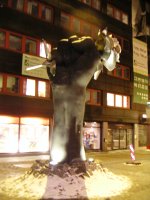 The earliest start we managed - getting up at 9am and out by 10am. Once again, the underfloor heating in the bathroom paid dividends. Our first stop was the front desk to pick up the most import thing to us for our stay: our Oslo passes. These cards grant us free transport on all the cities busses, trams, T-banes (undergrounds) and even ferries during the summer. We get free entry to all the public museums (normally about £6-ish) and 10% off at certain restaurants. We set off back to the station and down into the T-Bane - a cleaner, tramp free version of the underground. Our trip really demonstrated how small the city is; like London, the T-Bane comes above ground in the suburbs which happened a mere 10 minutes into our journey. The T-Bane slowly wound its way into the hills on the northwest side of the city and some time later we arrived at the unassuming Holmenkollen station.
The earliest start we managed - getting up at 9am and out by 10am. Once again, the underfloor heating in the bathroom paid dividends. Our first stop was the front desk to pick up the most import thing to us for our stay: our Oslo passes. These cards grant us free transport on all the cities busses, trams, T-banes (undergrounds) and even ferries during the summer. We get free entry to all the public museums (normally about £6-ish) and 10% off at certain restaurants. We set off back to the station and down into the T-Bane - a cleaner, tramp free version of the underground. Our trip really demonstrated how small the city is; like London, the T-Bane comes above ground in the suburbs which happened a mere 10 minutes into our journey. The T-Bane slowly wound its way into the hills on the northwest side of the city and some time later we arrived at the unassuming Holmenkollen station.

Oslo is on the coast, but we were now at over 250m above sea level. A steep pathway lead us towards one of the main sights of Oslo, the Holmenkollen ski jump and ski museum. The top of the jump towered above us as we approached the 1952 Olympic venue. We paused to look down into the runoff area and were amazed at how steep it is: you essentially fall a very long way when you jump (the current jump height is over 130m). Even more amazing is the fact that in the summer the stadium area fills with water to form a 25m deep lake! We continued to the museum which offered a broad range of displays on the history of skiing, Norweigen expeditions including that of the Fram which we would find out more about the following day, to the Olympics and how the skis vary for different events. 
Finally, the tour leads to an elevator and then a series of steep staircases (with very cold handrails) that lead up to the jumping platform. From here we got some amazing views of Oslo and the Oslofjord as well as seeing the pant-wetting sight that skijumpers see before they push off. It makes you wonder how people ever start out ski jumping. More worryingly, due to the lack of support under the booth itself, the whole place shook as people climbed the stairs.
 After heading back down (our height above sea level in the tower was about 600m) and heading back into the centre of town we experienced our first pølse. All the newstands, 7-11s and Kwik-E-Mart style places have grills with weiners on them. The pølse is traditionally served with lompe: a potato cake. At around NOK10 (about 90p) they offered surprising value considering the price of most food - they're cheap enough to get 2 or 3 of them. Of course, buying sausages from a newstand isn't without its risks but we survived.
After heading back down (our height above sea level in the tower was about 600m) and heading back into the centre of town we experienced our first pølse. All the newstands, 7-11s and Kwik-E-Mart style places have grills with weiners on them. The pølse is traditionally served with lompe: a potato cake. At around NOK10 (about 90p) they offered surprising value considering the price of most food - they're cheap enough to get 2 or 3 of them. Of course, buying sausages from a newstand isn't without its risks but we survived.
This time we headed to the northeast of the city to visit the Munch Museum. 
Unfortunately, Edvard Munch's most famous work, The Scream was stolen for the second time in 2004 and has yet to be recovered. Needless to say it's sitting on the wall of some millionaire's house somewhere. Security was tight and we had to leave out coats and bags in lockers and then proceed through a metal detector and put our pocket contents through an x-ray machine...The display itself was pretty good and offered a wide range of styles and artists.

It was nearly 4pm and was pretty dark outside, so we headed back to the hotel, picking up some supplies from a supermarket on the way, to relax for a few hours before heading out in search of food. We came prepared and had printed out the Wikitravel guide to Oslo which mapped the location of plenty of cheaper resaurants. This evening we chose a Vietnamese place. The restaurant was small and homely. The food was excellent (although the crab was very fiddly) and the chilli sauces caused some lip numbing. Thankfully the total cost came to less than £20 per person including drinks. It was fairly late so we headed home (there was no way we could afford to drink out). 
The main thing that struck us on our first full day in Oslo was how clean everything was - there was almost no litter, the T-Banes lacked the graffiti common to the tube. There were sculptures scattered throughout the streets that remained intact. The evening to saw no drunk locals staggering around or indeed any sign of trouble. Oslo, despite being one of Europe's largest capitals, has a population of under 500,000 allowing the city a fantastically relaxed atmosphere. During the whole trip we were never asked to show our passes on any public transport which seems to operate under a trust system. You wouldn't see that in London...
Remember, there are more photos on my MSN Space.

No comments:
Post a Comment